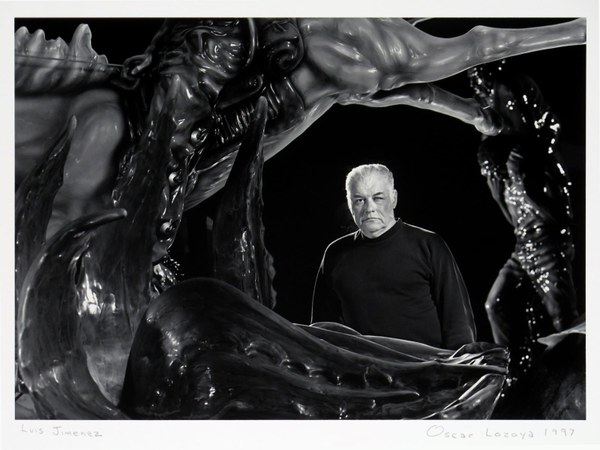Luís Jiménez: Motion and Emotion
January 16 – August 1, 2021
Oscar Lozoya (1953 Chihuahua, Mexico - 2019 Albuquerque, New Mexico), Luis Jimenez, 1997, gelatin silver print, Albuquerque Museum, museum purchase, 1993 General Obligation Bonds, PC1997.24.6
Luís Jiménez’s work covers a full swath of human emotions; at times his visual language is humorous, at other moments, it is heart wrenching and unabashedly political. His work often challenges viewers to confront myths and issues surrounding la frontera (the border) and the idea of cultural purity. Jiménez became well-known through his sculptures which incorporate bold colors, muscular figures, lively movement, political themes, and working class heroes. He used unorthodox materials like fiberglass, glitter, and lights as way to engage with Chicano culture. While much of the sculpture of the 60s and 70s in the United States tended toward abstraction and minimalism, Jiménez boldly focused on the figure creating characters that were larger than life and impossible to overlook in the public settings where they were placed. His drawing skills were equally vibrant, infused with a sense of movement and action. Many of the drawings and lithographs seen in this gallery were later realized as sculptures such as Southwest Pieta, Border Crossing, and Sodbuster.
Jiménez was born in El Paso, Texas to a Chicana mother and immigrant father from Mexico. He grew up working in his father’s neon sign studio which instilled in him a love for hard work and hand craft as well as a taste for bright color and action. His early work experience also introduced him to the material that would become one of his signatures: fiberglass. After receiving his BFA from the University of Texas, Austin in 1964, he lived in Mexico City for two years, studying the work of Mexican muralists like Diego Rivera, Jose Clemente Orozco, and David Alfaro Siqueiros. Clear influences from these artists, especially Orozco, are evident in Jiménez’s treatment of the figure – he emphasizes muscles, curves, sometimes even veins and tendons and drops of sweat, depicted through quick and lively marks. Jiménez spent six years in New York City before moving back to New Mexico in the early 1970s where he lived for the rest of his life.

